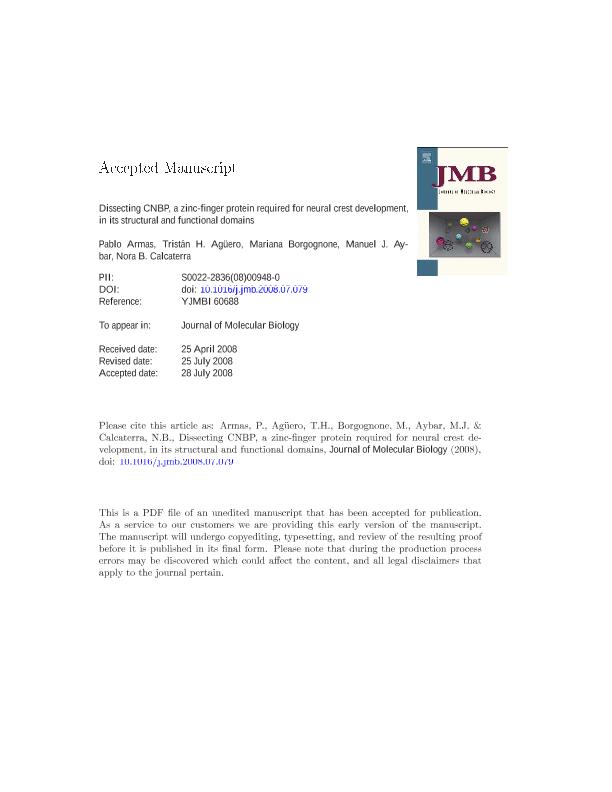Mostrar el registro sencillo del ítem
dc.contributor.author
Armas, Pablo

dc.contributor.author
Agüero, Tristán Horacio

dc.contributor.author
Borgognone, Mariana

dc.contributor.author
Aybar, Manuel Javier

dc.contributor.author
Calcaterra, Nora Beatriz

dc.date.available
2018-12-05T18:17:39Z
dc.date.issued
2008-10
dc.identifier.citation
Armas, Pablo; Agüero, Tristán Horacio; Borgognone, Mariana; Aybar, Manuel Javier; Calcaterra, Nora Beatriz; Dissecting CNBP, a Zinc-Finger Protein Required for Neural Crest Development, in Its Structural and Functional Domains; Academic Press Ltd - Elsevier Science Ltd; Journal Of Molecular Biology; 382; 4; 10-2008; 1043-1056
dc.identifier.issn
0022-2836
dc.identifier.uri
http://hdl.handle.net/11336/65879
dc.description.abstract
Cellular nucleic-acid-binding protein (CNBP) plays an essential role in forebrain and craniofacial development by controlling cell proliferation and survival to mediate neural crest expansion. CNBP binds to single-stranded nucleic acids and displays nucleic acid chaperone activity in vitro. The CNBP family shows a conserved modular organization of seven Zn knuckles and an arginine-glycine-glycine (RGG) box between the first and second Zn knuckles. The participation of these structural motifs in CNBP biochemical activities has still not been addressed. Here, we describe the generation of CNBP mutants that dissect the protein into regions with structurally and functionally distinct properties. Mutagenesis approaches were followed to generate: (i) an amino acid replacement that disrupted the fifth Zn knuckle; (ii) N-terminal deletions that removed the first Zn knuckle and the RGG box, or the RGG box alone; and (iii) a C-terminal deletion that eliminated the three last Zn knuckles. Mutant proteins were overexpressed in Escherichia coli, purified, and used to analyze their biochemical features in vitro, or overexpressed in Xenopus laevis embryos to study their function in vivo during neural crest cell development. We found that the Zn knuckles are required, but not individually essential, for CNBP biochemical activities, whereas the RGG box is essential for RNA-protein binding and nucleic acid chaperone activity. Removal of the RGG box allowed CNBP to preserve a weak single-stranded-DNA-binding capability. A mutant mimicking the natural N-terminal proteolytic CNBP form behaved as the RGG-deleted mutant. By gain-of-function and loss-of-function experiments in Xenopus embryos, we confirmed the participation of CNBP in neural crest development, and we demonstrated that the CNBP mutants lacking the N-terminal region or the RGG box alone may act as dominant negatives in vivo. Based on these data, we speculate about the existence of a specific proteolytic mechanism for the regulation of CNBP biochemical activities during neural crest development.
dc.format
application/pdf
dc.language.iso
eng
dc.publisher
Academic Press Ltd - Elsevier Science Ltd

dc.rights
info:eu-repo/semantics/openAccess
dc.rights.uri
https://creativecommons.org/licenses/by-nc-sa/2.5/ar/
dc.subject
Cellular Nucleic-Acid-Binding Protein
dc.subject
Neural Crest Development
dc.subject
Nucleic Acid Chaperone
dc.subject
Rgg Box
dc.subject
Zn Knuckle
dc.subject.classification
Otras Ciencias Biológicas

dc.subject.classification
Ciencias Biológicas

dc.subject.classification
CIENCIAS NATURALES Y EXACTAS

dc.title
Dissecting CNBP, a Zinc-Finger Protein Required for Neural Crest Development, in Its Structural and Functional Domains
dc.type
info:eu-repo/semantics/article
dc.type
info:ar-repo/semantics/artículo
dc.type
info:eu-repo/semantics/publishedVersion
dc.date.updated
2018-11-13T17:08:58Z
dc.journal.volume
382
dc.journal.number
4
dc.journal.pagination
1043-1056
dc.journal.pais
Países Bajos

dc.journal.ciudad
Amsterdam
dc.description.fil
Fil: Armas, Pablo. Consejo Nacional de Investigaciones Científicas y Técnicas. Centro Científico Tecnológico Conicet - Rosario. Instituto de Biología Molecular y Celular de Rosario. Universidad Nacional de Rosario. Facultad de Ciencias Bioquímicas y Farmacéuticas. Instituto de Biología Molecular y Celular de Rosario; Argentina
dc.description.fil
Fil: Agüero, Tristán Horacio. Consejo Nacional de Investigaciones Científicas y Técnicas. Centro Científico Tecnológico Conicet - Tucumán. Instituto Superior de Investigaciones Biológicas. Universidad Nacional de Tucumán. Instituto Superior de Investigaciones Biológicas; Argentina
dc.description.fil
Fil: Borgognone, Mariana. Consejo Nacional de Investigaciones Científicas y Técnicas. Centro Científico Tecnológico Conicet - Rosario. Instituto de Biología Molecular y Celular de Rosario. Universidad Nacional de Rosario. Facultad de Ciencias Bioquímicas y Farmacéuticas. Instituto de Biología Molecular y Celular de Rosario; Argentina
dc.description.fil
Fil: Aybar, Manuel Javier. Consejo Nacional de Investigaciones Científicas y Técnicas. Centro Científico Tecnológico Conicet - Tucumán. Instituto Superior de Investigaciones Biológicas. Universidad Nacional de Tucumán. Instituto Superior de Investigaciones Biológicas; Argentina
dc.description.fil
Fil: Calcaterra, Nora Beatriz. Consejo Nacional de Investigaciones Científicas y Técnicas. Centro Científico Tecnológico Conicet - Rosario. Instituto de Biología Molecular y Celular de Rosario. Universidad Nacional de Rosario. Facultad de Ciencias Bioquímicas y Farmacéuticas. Instituto de Biología Molecular y Celular de Rosario; Argentina
dc.journal.title
Journal Of Molecular Biology

dc.relation.alternativeid
info:eu-repo/semantics/altIdentifier/doi/http://dx.doi.org/10.1016/j.jmb.2008.07.079
Archivos asociados
